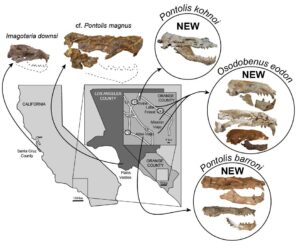Paleontologists Uncover Three New Species of Extinct Walruses in Orange County

Study Gives Insight to Tusk Evolution of the Marine Mammal
Millions of years ago, in the warm Pacific Ocean off the coast of Southern California, walrus species without tusks lived abundantly.
But in a new study, Cal State Fullerton paleontologists have identified three new walrus species discovered in Orange County and one of the new species has “semi-tusks” — or longer teeth.
The other two new species don’t have tusks and all predate the evolution of the long iconic ivory tusks of the modern-day walrus, which lives in the frigid Arctic.
The researchers describe a total of 12 specimens of fossil walruses from Orange, Los Angeles and Santa Cruz counties, all estimated to be 5 to 10 million years old. The fossils represent five species, with two of the three new species represented by specimens of males, females and juveniles.
Their research, which gives insights on the dental and tusk evolution of the marine mammal, was published today in the Journal of Vertebrate Paleontology.
Geology graduate Jacob Biewer, and his research adviser James F. Parham, associate professor of geological sciences, are authors of the study, based on fossil skull specimens.
Parham and Biewer worked with Jorge Velez-Juarbe, an expert in marine mammals at the Natural History Museum of Los Angeles County, who is a co-author of the paper. Velez-Juarbe is a former postdoctoral scholar in Parham’s lab and has collaborated on other CSUF fossil research projects. Parham is a research associate at the museum, which provides research opportunities for him and his students.
The researchers teamed to study and describe the anatomy of the specimens, most of which are part of the museum’s collection.
“Orange County is the most important area for fossil walruses in the world,” said Biewer, first author of the paper who conducted the research for his master’s thesis. “This research shows how the walruses evolved with tusks.”
Extinct Walrus Species Get Names
Today, there is only one walrus species and its scientific name is Odobenus.
For the new species found in Orange County, the researchers named the semi-tusked walrus, Osodobenus eodon, by combining the words Oso and Odobenus. Another is named Pontolis kohnoi in honor of Naoki Kohno, a fossil walrus researcher from Japan. Both of these fossils were discovered in the Irvine, Lake Forest and Mission Viejo areas.
Osodobenus eodon and Pontolis kohnoi are both from the same geological rock layer as the 2018 study by Parham and his students of another new genus and species of a tuskless walrus, Titanotaria orangensis, named after CSUF Titans. These fossils were found in the Oso Member of the Capistrano Formation, a geological formation near Lake Forest and Mission Viejo.
The third new walrus species, Pontolis barroni, was found in Aliso Viejo, near the 73 Toll Road. It is named after John Barron, a retired researcher from the U.S.Geological Survey and world expert on the rock layer where the specimens were found, Parham said.
Analysis of these specimens show that fossil walrus teeth are more variable and complex than previously considered. Most of the new specimens predate the evolution of tusks, Parham said.
“Osodobenus eodon is the most primitive walrus with tusk-like teeth,” Parham said. “This new species demonstrates the important role of feeding ecology on the origin and early evolution of tusks.”
Biewer explained that his work focused on getting a better understanding of the evolutionary history of the walrus in regards to its teeth.
“The importance of dental evolution is that it shows the variability within and across walrus species. Scientists assumed you could identify certain species just based on the teeth, but we show how even individuals of the same species could have variability in their dental setup,” said Biewer, who earned a master’s degree in geology in 2019.
“Additionally, everyone assumes that the tusks are the most important teeth in a walrus, but this research further emphasizes how tusks were a later addition to the history of walruses. The majority of walrus species were fish eaters and adapted to catching fish, rather than using suction feeding on mollusks like modern walruses.”
Biewer, now a paleontologist in the Modesto area, also examined whether climate changes in the Pacific Ocean had an impact on ancient walruses. His work suggests that a rise in water temperature helped to boost nutrients and planktonic life, and played a role in the proliferation of walruses about 10 million years ago, which may have contributed to their diversity.
Sidebar:
For the fossil walrus research project, geology graduate Jacob Biewer spent hours in the lab measuring and describing the walrus bones.
“I sat many hours with a handy caliper taking notes on the lengths of teeth and width of skulls, among many other measurements,” he said. “Describing bones is much more in depth and meticulous than it sounds. There are traits that the bones of each walrus species have — the size, shape and number of teeth. I recorded how the bones are different from, or similar to, other extinct walrus species.”
Biewer, a paleontologist who lives in Modesto, noted that despite the pandemic, he and Parham worked on the scientific paper with 300 miles of social distancing.
Completing his first journal publication, based on his master’s work, and conducting the research project helped him to understand scientific methods and techniques that he now uses in his career, where he monitors construction sites for paleontological resources. He also teaches undergraduate geology courses at Cal State Stanislaus, where he earned a bachelor’s degree in geology, and is considering pursuing a doctorate.
“The experiences I had in conducting this research, especially the presentations at national paleontological conferences, led to a big increase in my confidence in my scientific abilities,” Biewer said. “I credit my time working with Dr. Parham directly to the achievements in my current employment — from the skills he imparted to the doors he helped open.”